Date of Incident
Publication Date
Updated
Commissioned By
Additional Funding
Collaborators
Methodologies
Forums
Introduction
Since the start of Israel’s military campaign in Gaza in October 2023, Forensic Architecture has been collecting data related to attacks on civilians and civilian infrastructure by the Israeli military. Our analysis of this conduct reveals the near-total destruction of civilian life in Gaza. We have also collected and analysed evacuation orders issued by the Israeli military directing Palestinian civilians to areas of Gaza designated as ‘safe’. These orders have resulted in the repeated, large-scale displacement of the Palestinian population across Gaza, often to areas which subsequently came under attack.
The patterns we have observed concerning Israel’s military conduct in Gaza indicate a systematic and organised campaign to destroy life, conditions necessary for life, and life-sustaining infrastructure.
Forensic Architecture’s monitoring and research consists of:
- An interactive cartographic platform: ‘A Cartography of Genocide’
- An 827-page text report: ‘A spatial analysis of the Israeli military’s conduct in Gaza since October 2023’
The platform and report present a comprehensive mapping of military conduct in Gaza since 7 October 2023. They deploy spatial and pattern analysis to observe the ways in which Israel’s military operations entailed widespread civilian harm.
To identify patterns in Israel’s conduct, the platform turns thousands of datapoints into a navigable ‘map’ of Gaza, within which it is possible to define regions, periods in time, and categories of events. This filtering can reveal trends within datasets and relationships between different datasets (for instance, between the military ground invasion and the destruction of medical infrastructure).
In our analysis, we understand patterns to mean the repetition of same, similar or related incidents, at different times and places. Such patterns may indicate that these attacks are designed, formally or informally, rather than occurring at random.
Our report analyses Israeli military conduct between 7 October 2023 and 16 September 2024. It interrogates the scale and nature of attacks, the extent of damage and the number of victims, as well as the organised nature of the acts of violence and the improbability of their random occurrence.
Areas of Analysis
We collected and analysed data across six areas:
- Spatial Control – the physical shaping of Gaza according by a strategic design;
- Displacement – the repeated, forced displacement of civilians and an assessment of Israel’s ‘humanitarian measures’;
- Destruction of Agriculture and Water Resources – the destruction of fields, orchards, greenhouses, agricultural and water infrastructure;
- Destruction of Medical Infrastructure – the systematic targeting of hospitals and healthcare workers;
- Destruction of Civilian Infrastructure – the targeting of public utilities, roads, schools including those acting as shelters, religious buildings, and government buildings;
- Targeting of Aid – the systematic targeting of infrastructure and personnel necessary for the transport and distribution of humanitarian aid and the preparation of food.
Each area of analysis consists of (1) quantitative findings and (2) pattern findings.
Because military actions are multifaceted, patterns can exist across actions. The effect of military actions on Gaza’s civilian population may not be fully captured by studying the repetition of a single type of action in isolation. The simultaneous, or proximate, application of different types of action in the same territory may generate a cumulative and compounded effect, each action aggravating the effect of another.
By ‘layering’ multiple cartographic datasets over one another, we could:
- analyse the compounded effects of different types of acts;
- determine whether relations between different types of acts repeat across time and space;
- determine whether these relations are random or display an organised design;
- and determine the relation between military acts and the natural characteristics of Gaza by layering the mapping of these acts over meteorological and soil-type maps.
We explore these interrelations in Chapter 8: Cross-Sectional Analysis in our report.
Note:
We use the term ‘genocide’ within the meaning developed by Raphael Lemkin, whose thinking behind this term was instrumental for the definition formulated in Article II of the Genocide Convention. Genocide, according to Lemkin, signifies a coordinated plan of actions aimed at the destruction of essential foundations of the life of national groups, with the aim of annihilating the groups themselves. [See Raphael Lemkin, Axis Rule in Occupied Europe Laws of Occupation; Analysis of Government; Proposals for Redress (Washington Carnegie Endowment For International Peace, Division Of International Law 1944) 79].
> Read our summary of findings
> Read our methodology overview
Spatial Control: Summary of Findings
Israel has built a new system of spatial control in Gaza, re-shaping the territory by destroying agricultural lands and buildings to create infrastructure for a permanent military presence.
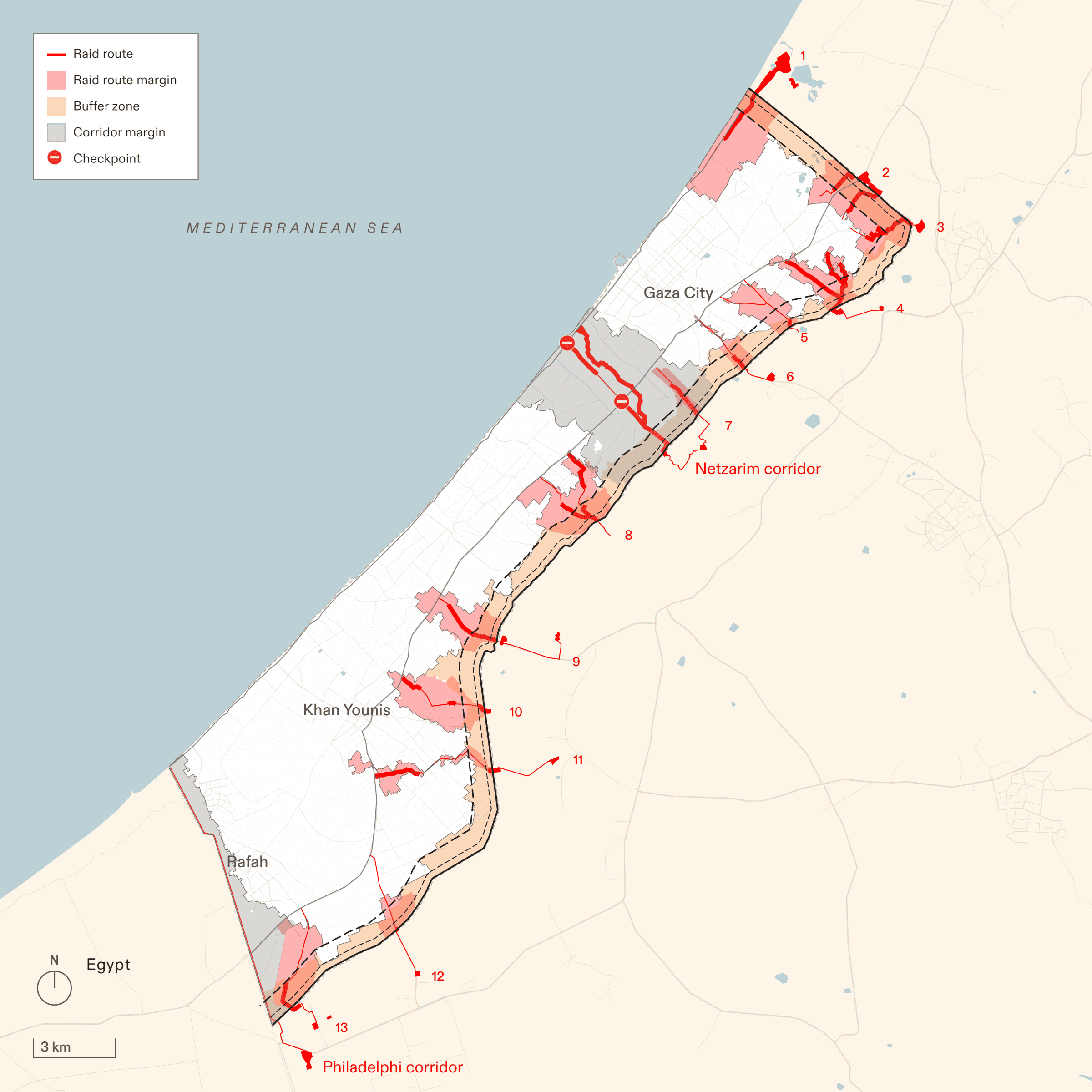
Quantitative findings
We have documented the following elements of Israel’s system of spatial control:
- Buffer zone: A 1km-wide zone along Gaza’s eastern perimeter, within which most buildings and all agricultural infrastructure have been destroyed.
- Netzarim corridor: A 6.5 km road with 2-3.5 km of cleared margins on its south side, and 1.7-3.5 km on its north side, bisecting Gaza north of Wadi Gaza, within which most buildings and agriculture have been destroyed
- Checkpoints: Two permanent checkpoints at the intersections of the Netzarim corridor with the main north-south arteries (Salah al-Din and al-Rashid Roads), plus four temporary checkpoints across Gaza.
- Raid routes: Thirteen routes from Israeli military bases into Gaza. The construction of these roads often involved the destruction of most buildings and agricultural lands in their path.
- Philadelphi corridor: A widened strip running east to west along Gaza’s southern border with Egypt.
We have documented the destruction and clearing of land for the establishment of the above elements:
- Total cleared land: 131.7 sq km (36% of Gaza). The buffer zone, the ‘corridors’, and the raid routes partially overlap.
- Buffer zone: 55 sq km (15% of Gaza).
- Netzarim corridor: 35 sq km (9.6% of Gaza).
- Raid routes: 62 sq km.
- Philadelphi corridor: 10.8 sq km.
Pattern Findings
- Israel’s military campaign involved the reshaping of cultivated and built environment through acts of destruction and construction. Our analysis found that these acts of destruction and construction were not haphazard, but followed consistent and clear spatial logic:
- Agricultural destruction: All farmland within these areas was destroyed. The construction of new infrastructural elements has likely contaminated the soil and inhibiting future use.
- Creating ‘zones’: The Netzarim corridor divides Gaza into two zones: a civilian-evacuated ‘north’ and a ‘south’ which includes designated ‘destination areas.’
- The Netzarim corridor and the checkpoints facilitate displacement:
- Movement between the zones is restricted and controlled by checkpoints
- Checkpoints exclusively allow southward civilian movement.
- Thirteen raid routes lead from the perimeter to the interior of Gaza.
- These routes facilitated repeated military incursions.
- The extent of work invested in their construction suggests they may have long-term presence.
Displacement: Summary of Findings
Israel weaponised ‘protective measures’ by using evacuation orders to repeatedly displace civilians to areas which were then attacked.
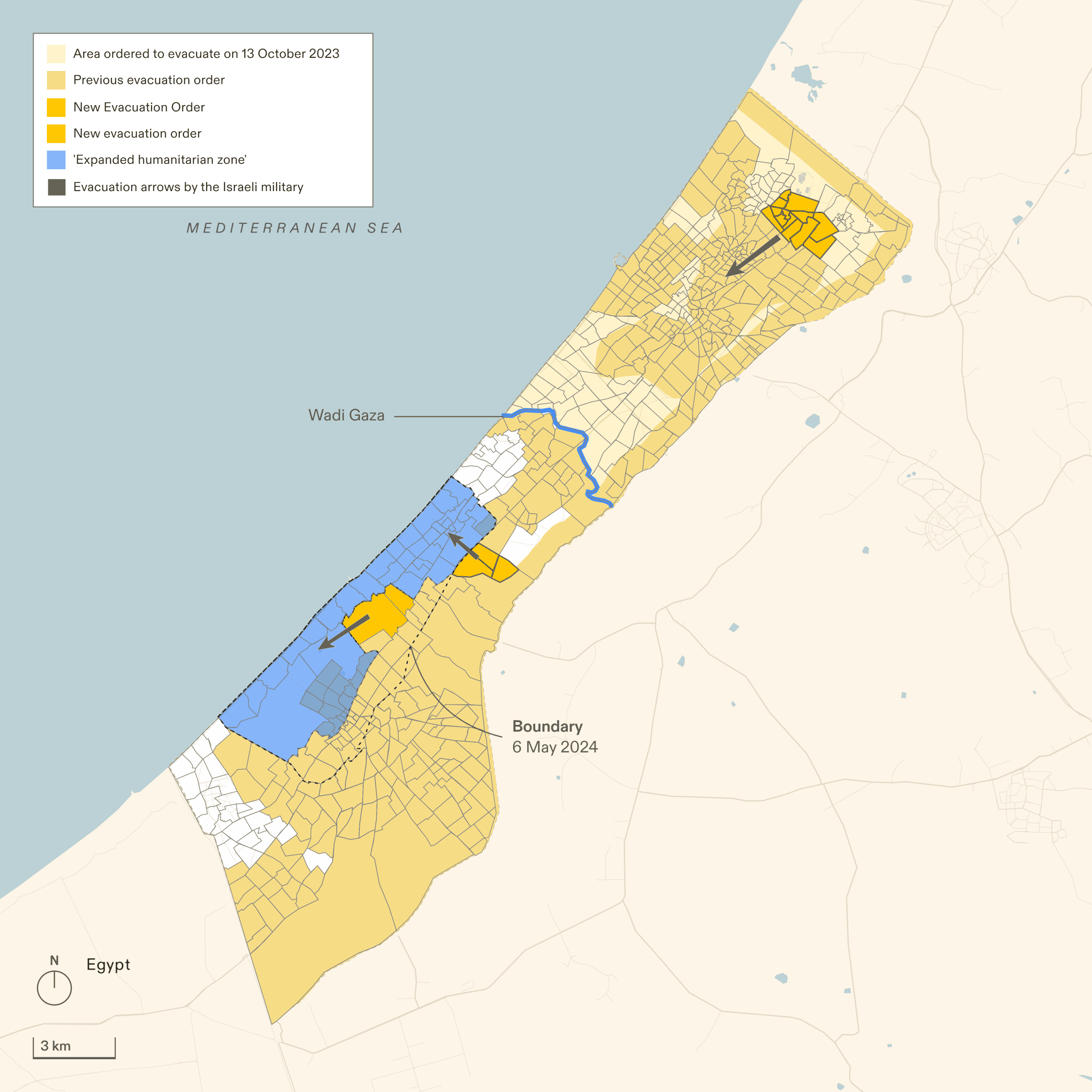
Quantitative Findings
- Destination areas (areas to which the Israeli military has ordered civilians to move, including the Israeli designated ‘humanitarian zone’) decreased significantly from October 2023 to August 2024, contracting from 228.2 sq km (62.5% of Gaza) to 47.4 sq km (13% of Gaza).
- On 13 October 2023, this area included all of Gaza south of Wadi Gaza and covered 228.2 sq km (62.5%) of the total territory of Gaza.
- On 7 January 2024, it included Rafah, Deir al-Balah and the al-Mawasi ‘humanitarian zone’, covering 80.7 sq km (22.1%) of Gaza.
- On 6 May 2024, it shrank to include only the newly established ‘expanded humanitarian zone’, covering 60.9 sq km (16.6%) of Gaza.
- On 16 August 2024, the ‘humanitarian zone’ contracted. The area covers 37.9 sq km (10.4%) of Gaza.
- On 30 August 2024, three blocks have been reintegrated to the ‘expanded humanitarian zone’, expanding its extent to covering 47.4 sq km (13%) of Gaza.
- The boundaries of the ‘humanitarian zone’ established from 18 October 2023 changed 9 times by 30 August 2024.
- Between 7 October 2023 and 31 August 2024, 84% of Gaza’s total area was subject to evacuation orders.
- The first evacuation order on 13 October covered 37% of Gaza.
- Between 1 December 2023 and 31 August 2024, 72% of Gaza’s total area was subject to evacuation orders.
- After December 2023, 72% of Gaza received at least one evacuation order.
- By May 2024, only 6.9% of Gaza’s territory, excluding the ‘humanitarian zone’, had not received an evacuation order.
- 66 evacuation orders were issued between 7 October 2023 and 31 August 2023. Most orders refer to multiple blocks at a time.
- 346 schools were used as shelters, 70% of which were subsequently attacked (UN data).
Pattern Findings
- The Israeli military continuously attacked all areas of Gaza: destination areas (including the ‘humanitarian zone’); Israeli designated ‘safe routes’; undefined areas (including civilian shelters); civilians from within evacuation areas.
- Destination areas have decreased in size, even as the displaced population has increased.
- The Israeli military’s use of evacuation orders has put civilians at risk by:
- Issuing inconsistent and incomplete information about the ‘humanitarian zone’.
- Issuing unclear and inconsistent evacuation orders.
- Instructing civilians to evacuate to areas that were attacked soon after.
- Issuing evacuation orders after having already begun military operations within the area in question.
- Issuing a sequence of evacuation orders that displaced civilians multiple times.
- Instructing civilians to displace to areas that had recently received evacuation orders.
- Failing to specify the duration or expiry of evacuation orders.
- Displacing civilians to destination areas that were previously targeted and destroyed.
- The Israeli military besieged displaced civilians and funnelled into checkpoints where they were surveilled.
- The Israeli military used ‘protective measures’ to displace Palestinians:
- First, civilians were directed from the north to the south of Gaza.
- Then, civilians were directed from the east to the west of Gaza.
Destruction of Agriculture and Water Resources: Summary of Findings
The Israeli military destroyed agriculture and water resources across Gaza, in a manner which was cumulative, repetitive, and with long-term effects.
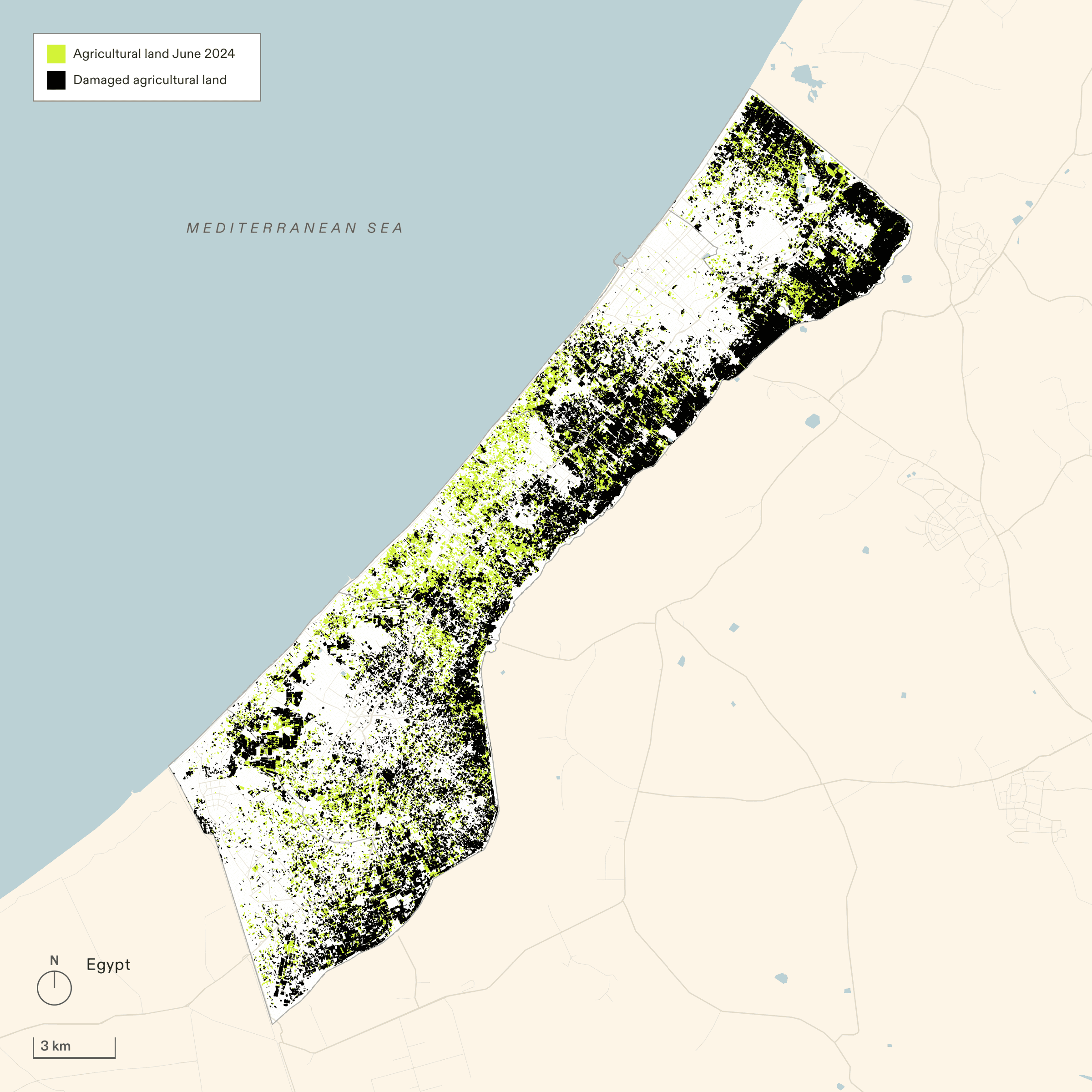
Quantitative findings
Between 7 October 2023 and 30 June 2024:
- Approximately 83% of all plant life in Gaza was destroyed.
- Approximately 70% of Gaza’s agricultural land, 104 sq km (out of 150 sq km) of fields and orchards, were destroyed.
- More than 3,700 greenhouse structures in Gaza, 45% of its total, were destroyed.
- More than 47% of groundwater wells and 65% of water tanks were destroyed or damaged. The status of 29% of the wells is unknown.
- None of the wastewater treatment facilities in Gaza have remained intact or functional.
Pattern findings
- The Israeli military repeatedly destroyed agriculture and water resources across Gaza.
- Month-by-month analysis in this period shows a correlation between the destruction of agricultural lands and infrastructure, and the Israeli military’s ground position.
- The destruction of agricultural lands and infrastructure was cumulative and repeated.
- The Israeli military’s conduct has likely caused contamination in Gaza’s land and water resources.
Destruction of Medical Infrastructure: Summary of Findings
Israel repeatedly targeted hospitals and other medical infrastructure, suggesting an intention to destroy Gaza’s medical system.
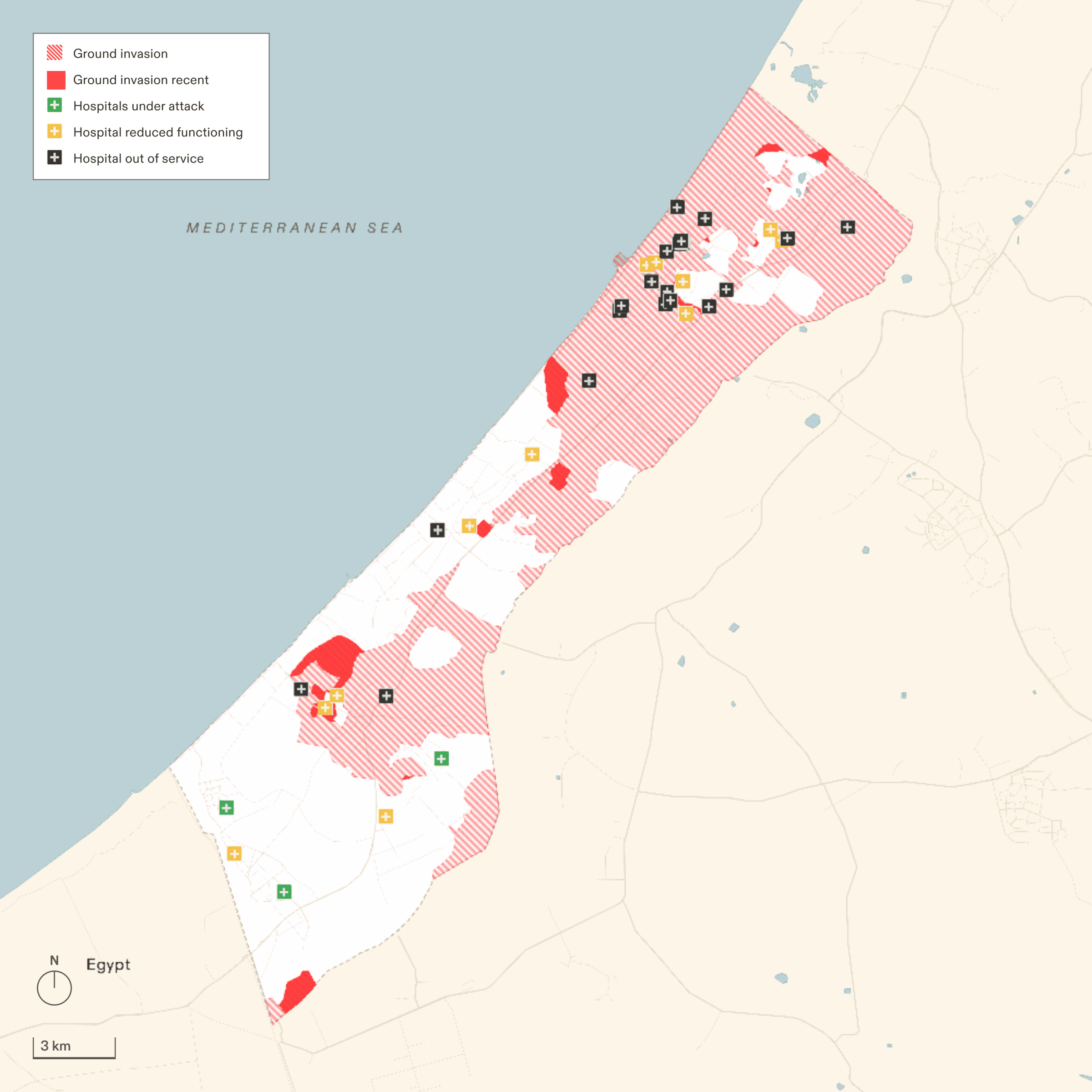
Quantitative Findings
Between 7 October 2023 and 1 August 2024:
- Hospitals out of service: 35 of 36 at least once.
- Directly targeted: 31 of 36 hospitals.
- Under siege: 11 hospitals, with 5 under siege twice.
- Invaded: 10 hospitals, with 4 invaded twice.
- Field hospitals: 4 evacuated and forced out of service.
- 1 hospital (Patient’s Friends Society Hospital) has been attacked and forced out of service twice, having rebuilt and reestablished operations.
- 27 hospitals are within areas that received evacuation orders.
Pattern Findings
- The Israeli military’s targeting of hospitals follows a consistent and discernible pattern of five typically consecutive phases:
- Evacuation orders (27 hospitals),
- Surrounding areas attacked (29 hospitals),
- Direct attacks (31 hospitals),
- Siege (11 hospitals),
- Invasion (10 hospitals).
- The Israeli military’s attack on hospitals correlates with the advancement and presence of Israeli ground forces.
- The first hospitals in Gaza forced out of service by Israeli attacks were in areas into which the ground invasion first advanced;
- The position of the Israeli ground forces correlates with where hospitals were subsequently forced out of service;
- When large hospitals were attacked by Israeli ground forces, small hospitals in the surrounding area were often also attacked and forced out of service.
- Sites of medical infrastructure where healthcare services were either reestablished or newly introduced were subsequently targeted by the Israeli military.
- The timing of the Israeli military’s attacks on hospitals correlates with the presence of displaced civilians at those hospitals.
- The Israeli military targeted medical personnel and facilities in a manner which caused damage to Gaza’s medical system.
- Healthcare workers have been direct targets of the Israeli military, as opposed to being indirect casualties of attacks on hospitals;
- The Israeli military destroyed and occupied hospitals even after they had been forced out of service and evacuated;
- The Israeli military’s targeting of hospitals caused damage to Gaza’s maternity services.
Destruction of Civilian Infrastructure: Summary of Findings
Israel’s attacks on civilian infrastructure suggests an effort to destroy the ability to sustain civilian life and disrupt civilian access to critical infrastructure.
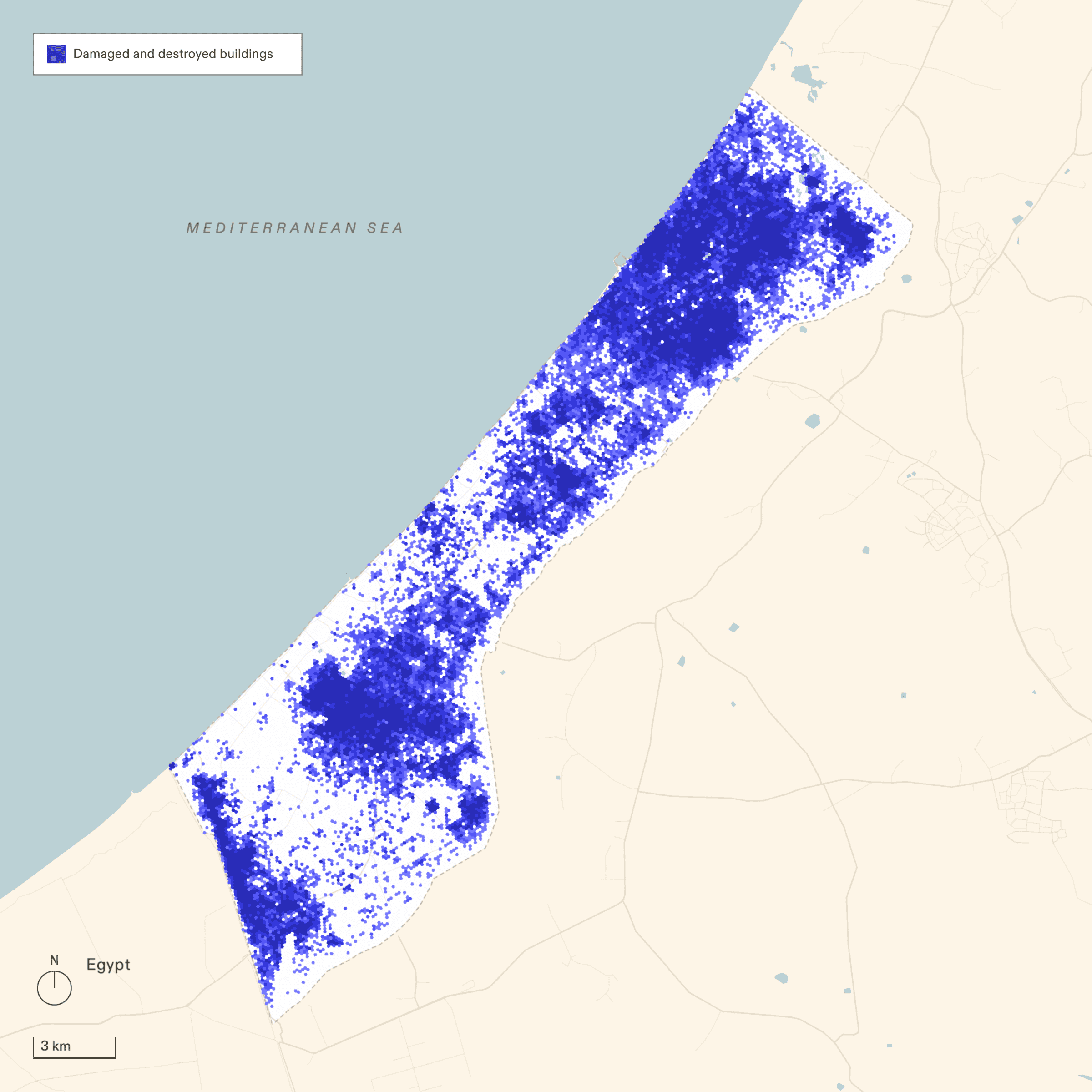
Quantitative Findings (7 October 2023 – 6 July 2024)
- Health facilities: 57% attacked; 45 damaged, 18 destroyed (of 110).
- Shelters: 71% attacked; 219 damaged, 31 destroyed (of 353).
- Utilities: 53% attacked; 166 damaged, 152 destroyed (of 605).
- Schools: 75% attacked; 334 damaged, 91 destroyed (of 564).
- University facilities: 81% attacked; 18 damaged, 18 destroyed (of 44).
- Government buildings: 82% attacked; 17 damaged, 20 destroyed (of 45).
- Religious institutions: 80% attacked; 143 damaged, 130 destroyed (of 341).
- Cultural sites: 91% attacked; 10 damaged, 30 destroyed (of 44).
- Roads: 47.3% damaged in North Gaza (7 Oct – 7 Nov); 33.7% in South Gaza (7 Oct – 7 Jan).
Between 5 May to 6 July 2024:
- 10,308 structures damaged; This is more than double the number of structures destroyed in the previous two months.
- 9,524 structures destroyed; This is three times higher than the number of damaged structures in the previous two months.
Pattern Findings
7-28 October 2023 (aerial bombing campaign)
- Timing: Strikes correlated with the time at which a higher density of civilians would be expected to be present; residential areas were hit more at night, commercial spaces during operating hours.
- Distribution: Israel’s attacks south of Wadi Gaza increased after it ordered civilians from the north to evacuate to the south.
7 October 2023 – 6 July 2024 (wider military campaign)
- Public infrastructure was destroyed even after it had been previously damaged, and when it was unlikely to be occupied.
- Areas in proximity to critical infrastructure were targeted:
- We observed repeated damage to service roads immediately surrounding critical infrastructure.
- We observed repeated destruction of buildings in the same vicinity, leading to accumulation of debris on the roads surrounding critical infrastructure.
- Repeated disruption of road networks isolated civilians in two ways:
- It was more difficult for civilians to leave areas in which infrastructure had been destroyed.
- It was more difficult for aid to reach civilians in those areas disconnected from the road network.
Targeting of Aid: Summary of Findings
Israel targeted sites and systems of humanitarian aid delivery and distribution when and where they became the main mode of aid facilitation.
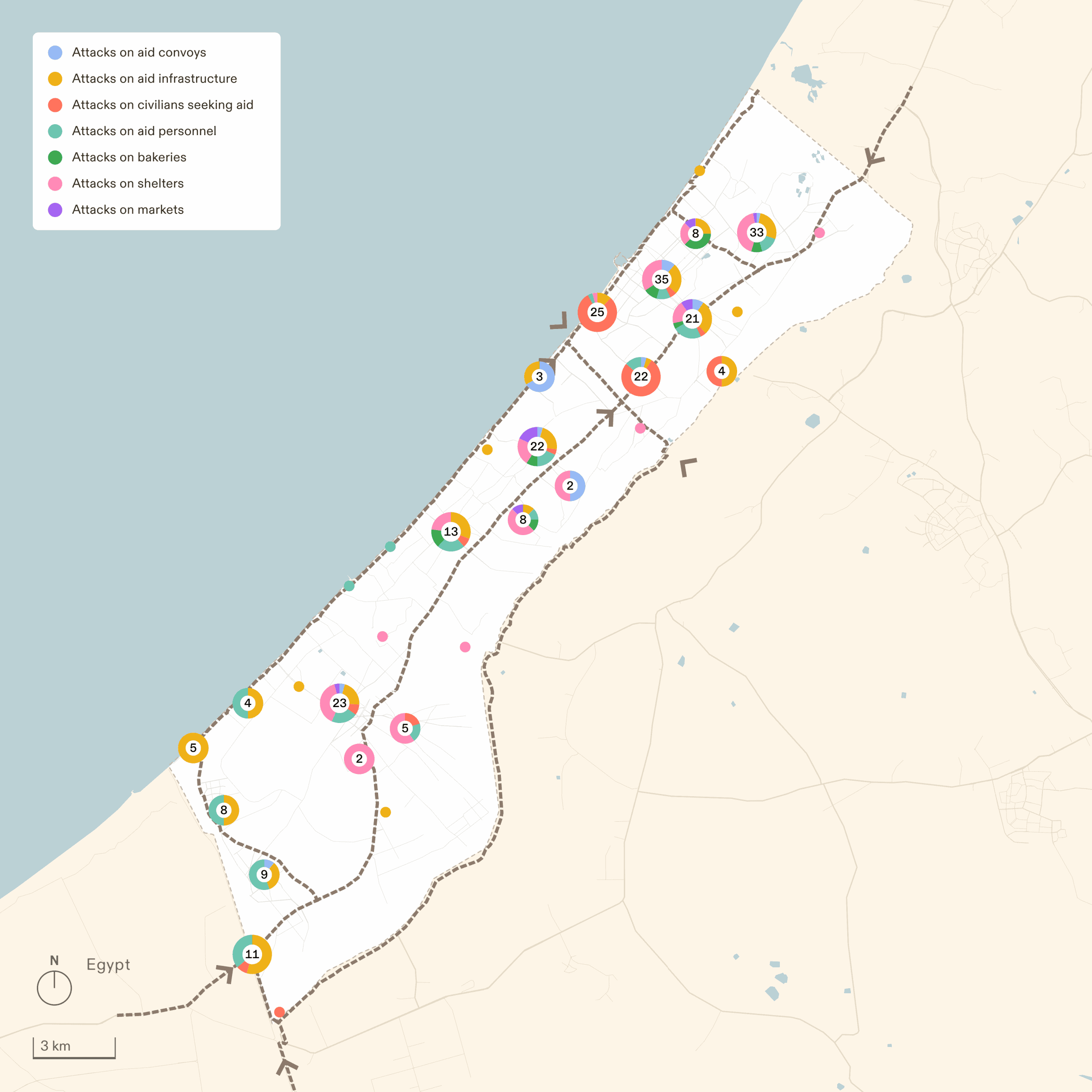
Quantitative Findings
- Total incidents of targeting aid: 322
- Attacks by category: 17 on bakeries, 73 on shelters, 60 on aid personnel, 50 on civilians seeking aid, 78 on aid infrastructure sites such as warehouses and water treatment facilities, 22 on aid convoys, 6 on aid convoys by Israeli vigilantes en route through Israel or the West Bank, 16 on markets.
- At least 17 of the attacks on aid personnel, convoys, and infrastructure targeted sites involved in operations that had been officially coordinated with Israel and recognised as ‘deconflicted sites’.
- UNRWA targeting: 39 attacks on UNRWA personnel and assets; 195 UNRWA personnel killed (177 staff members, 18 other aid workers), 40 detained by the Israeli military.
Pattern Findings
- We observed that the Israeli military’s targeting of aid followed a pattern of overlapping phases, during which attacks on the specified aid categories intensified
- October–November 2023: Bakeries in the north of Gaza were targeted when they played a critical role in aid distribution. By mid-November there were no official bakeries still in operation in Gaza City.
- October 2023–January 2024: Shelters were targeted when they assumed a central role in housing people displaced by Israeli attacks, and facilitating the receipt and preparation of food aid.
- December 2023–February 2024: Palestinian police officers (aid personnel) were targeted when they played a critical role in escorting aid convoys.
- January–March 2024: Civilians gathering for aid near the Netzarim corridor checkpoints were repeatedly targeted.
- March 2024: Aid administrators from organisations and groups that took up responsibility for facilitating aid delivery and distribution (aid personnel) were targeted when they began to play a prominent role in its organisation. Attacks on these personnel and organisations were extensive enough to eliminate their key administrators or otherwise force them to cease operating.
- October 2023, December 2023, May 2024: Aid distribution and storage sites, including warehouses and markets, were targeted when they were actively operating to supply civilians with food, with severe attacks on Rafah crossing, Karem Abu Salem/Kerem Shalom crossing, and markets during periods of increased aid-entering.
- May 2024: Israeli vigilantes attacked aid convoys passing through Israel and the occupied West Bank under the watch and sometimes with direct support of Israeli military personnel.
- Increases in aid flow into Gaza (late December 2023; late March, April, and May 2024) coincided with an increase in Israel’s targeting of Gaza’s aid distribution systems, including logistics, personnel and necessary infrastructure.
- The targeting of aid occurred in tandem with the Israeli military’s evacuation orders and coincides with its attempts to force Palestinian civilians to displace from the north of Gaza.
The construction of the new internal border in the Netzarim corridor and the checkpoints within it supporting a one-way (north to south) movement of civilians coincided with the restriction of aid as a means of displacement.
The report, ‘A Spatial Analysis of the Israeli Military’s Conduct in Gaza since October 2023,’ is derived from Forensic Architecture’s ongoing research into the Israeli military’s conduct in Gaza and was provided to the legal team representing South Africa in the case of the Application of the Convention on the Prevention and Punishment of the Crime of Genocide in the Gaza Strip (South Africa v. Israel), after being approached by the legal team representing South Africa to provide independent research and reporting for their ongoing submission in this case. For the provision of this report, Forensic Architecture received payment from the South African Government.